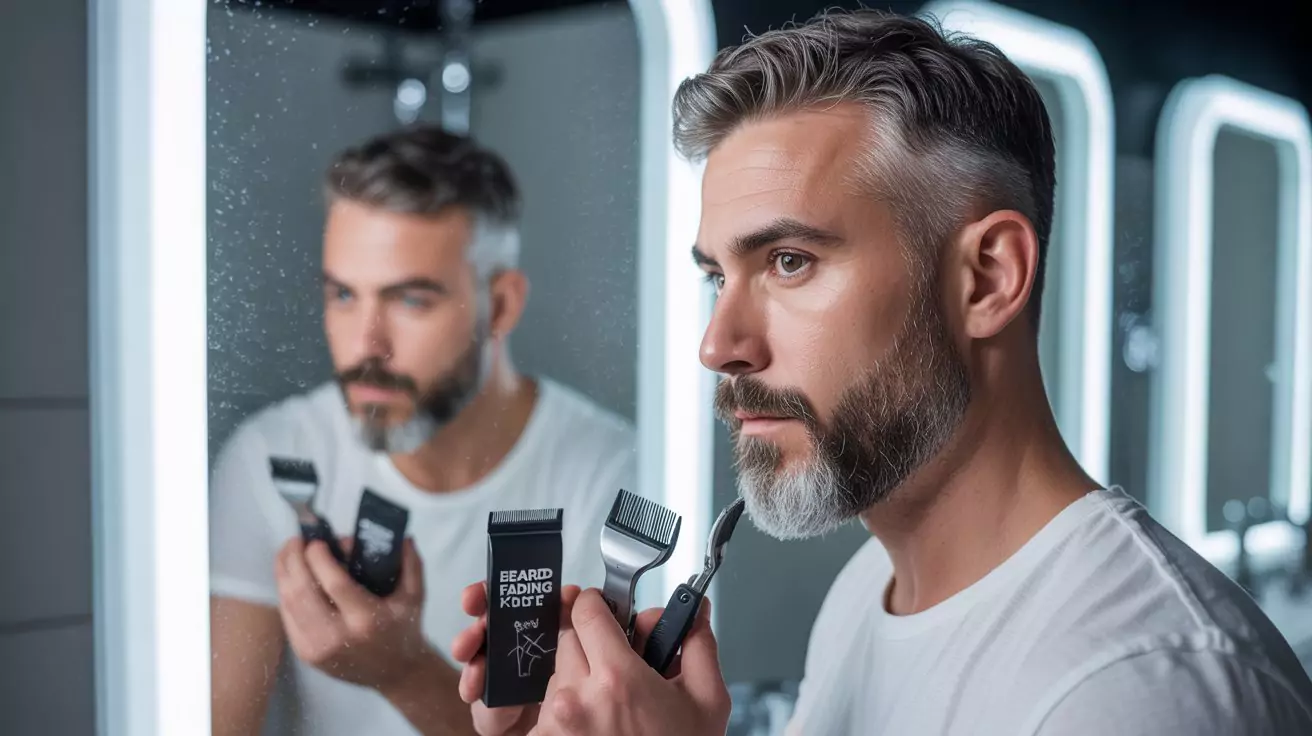Transform your haircutting skills with proven Haircut Techniques and Tools and expert insights that create salon-quality results every time.
The gap between amateur cuts and professional results isn’t talent—it’s mastery of fundamental hair cutting techniques combined with precision tool usage. After studying thousands of successful salon transformations and consulting with master stylists across the globe, this comprehensive guide reveals the exact methods that separate exceptional stylists from the rest.
Professional hairdressing thinning tools and techniques work together like instruments in an orchestra. Each element must perform its role perfectly to create the harmonious result clients expect. This guide breaks down complex cutting methods into manageable steps, ensuring you develop the muscle memory and technical understanding that produces consistent, stunning results.
Master stylist Jennifer Chen, with over 30 years of salon experience, puts it perfectly: “Great haircuts aren’t accidents—they’re the inevitable result of understanding your tools, respecting the hair’s natural characteristics, and executing proven techniques with precision.”
Essential Hair Cutting Tools: Building Your Professional Arsenal
Professional Cutting Shears: The Foundation of Excellence
Professional cutting shears represent your most important investment as a stylist. The difference between struggling through cuts and executing them effortlessly often comes down to shear quality and selection.
Convex edge shears feature ultra-sharp, razor-like cutting surfaces that slice through hair with minimal pressure. These shears excel at Haircut Techniques and Tools work, detail cutting, and creating clean lines. Japanese steel convex shears, particularly those made with VG-10 or ATS-314 steel, maintain their edge longer and cut more smoothly than cheaper alternatives.
For a fade haircut uses clippers, guard sizes, and a comb to blend hair from long to short. The key technique is gradually switching guards and using upward strokes for a smooth transition.
The Hikari Cosmos series, for example, uses cobalt-infused steel that stays sharp 40% longer than standard steel. Professional stylists report these shears reducing hand fatigue during long cutting sessions while producing cleaner cuts that require less finishing work.
Beveled edge shears feature slightly angled cutting surfaces that provide more durability and forgiveness. They’re excellent for learning best hair cutting techniques because they’re less likely to create damage if your cutting angle isn’t perfect. German steel beveled shears offer exceptional reliability for daily salon use.
Blade length selection directly impacts your cutting efficiency and results:
4.5-inch shears excel at precision work, cutting bangs, and detail finishing. Their shorter length provides maximum control for intricate work around the face and ears.
5.5-inch shears handle most general cutting tasks efficiently. They provide the perfect balance of control and cutting capacity for layering techniques and basic shape creation.
6.5-inch shears work best for long hair layering and bulk removal on thick hair. The additional length allows you to cut larger sections while maintaining control.
7-inch shears are specialized tools for serious length cutting on very long hair. They’re essential for stylists who regularly work with hair longer than 12 inches.
Handle design affects your comfort and cutting precision. Offset handles position your thumb naturally, reducing wrist strain during extended cutting sessions. Crane handles provide even more ergonomic benefit by angling the thumb ring further forward.
“Your shears should feel like a natural extension of your hand. If you’re fighting your tools, you can’t focus on creating beautiful cuts.” – Master stylist Maria Rodriguez, 25+ years experience
Texturizing Tools That Transform Ordinary Cuts
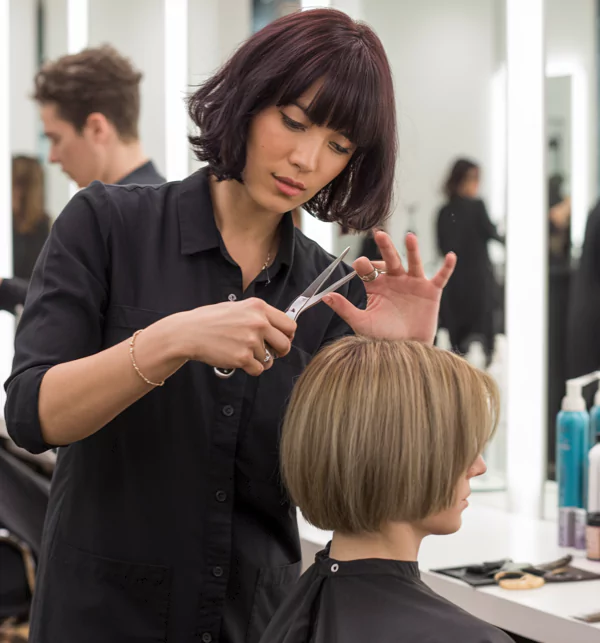
Texturizing shears revolutionize how you add movement, reduce bulk, and create modern, lived-in looks. Understanding when and how to use different texturizing tools separates contemporary stylists from those stuck in outdated methods.
Blending shears with 30-40 teeth create subtle texture perfect for softening blunt Haircut Techniques and Tools. The high tooth count removes approximately 15-20% of hair per cut, making them ideal for final touches and seamless blending between sections.
The Sam Villa Signature Series Texturizer features 32 precisely-engineered teeth that create consistent texture without creating holes or choppy sections. Professional stylists use these for adding texture to hair while maintaining the overall shape integrity.
Chunking shears with 7-15 teeth remove 25-40% of hair per cut, making them powerful tools for dramatic texture changes. They’re perfect for texturizing short hair and removing significant bulk from thick, dense hair.
Thinning shears with 20-25 teeth offer middle-ground performance, removing approximately 20-30% of hair. They work excellently for general texture work and blending layered sections.
Point cutting technique uses regular cutting shears to create soft, feathered edges. Point your shears into the hair ends at a 45-degree angle, making small snips that create irregular lengths. This technique prevents harsh lines and adds natural movement to any cut.
Advanced point cutting involves varying your angle and depth to create different texturing effects. Shallow point cutting (1/4 inch deep) creates subtle softness, while deeper point cutting (1/2 inch) produces more dramatic texture.
Slide cutting involves opening your shears partially and sliding them down the hair shaft while applying gentle closing pressure. This technique removes weight without affecting overall length—perfect for maintaining shape while adding movement.
Professional slide cutting requires sharp shears and confident hand movements. Start with the shears fully open, position them mid-shaft, then slowly close while sliding toward the ends. The key is maintaining consistent pressure and speed.
Razor cutting creates ultra-soft texture with a completely different feel than shear cutting. The Sam Villa Signature Series Razor features a unique design that allows for both detail work and broader texturizing.
Razor techniques require damp hair and confident strokes. Unlike shears, razors cut by slicing through the hair shaft at an angle, creating tapered ends that move naturally when styled.
Support Equipment for Professional Results
Quality sectioning clips prevent the frustration of hair falling into your work area. Look for clips with strong, consistent springs and smooth surfaces that won’t snag or damage hair. Double-prong clips hold more hair securely, while single-prong clips work better for fine or thin hair.
Professional cutting combs and hair clippers serve multiple crucial functions. The Hercules Sägemann 600 series combs feature seamless construction with both wide and fine teeth. Wide teeth section hair cleanly without tangling, while fine teeth create precise partings for sectioning hair techniques.
Carbon fiber combs resist static and maintain their shape under heat, making them ideal for cutting and styling. They’re also more durable than plastic combs and provide better grip control during cutting.
Professional spray bottles maintain consistent moisture levels during wet cutting. Choose bottles with adjustable nozzles that provide both fine mist and directed spray. The Salon Pro Continuous Spray Bottle delivers consistent pressure without pumping, keeping one hand free for cutting.
Haircut capes protect clients’ clothing while providing easy cleanup. Look for capes with snap closures rather than ties for faster client turnover. Water-resistant materials prevent moisture from reaching clothes during washing and cutting.
Foundation Techniques That Transform Your Cutting
DIY-How to Cut Your Own Hair for Men
Learning how to cut your own hair for men has become more than just a money-saving hack—it’s a valuable life skill. With barbershop visits averaging $28 nationwide and rising costs making regular trims expensive, mastering DIY haircut techniques puts you in control of your grooming routine.
Along with trimming your hair, you can try a beard fade by blending your haircut into your facial hair using clippers and guard sizes for a sharp, professional look.
Elevation in Haircutting: Mastering Vertical Control
Elevation in haircutting controls weight distribution and determines the fundamental shape of every haircut. Understanding elevation angles transforms cutting from guesswork into precise shape creation.
0-degree elevation (no lift) creates maximum weight and solid perimeters. When you comb hair straight down and cut without lifting, you maintain all possible weight in the perimeter. This technique works perfectly for one-length bob cuts and creating strong, geometric shapes.
The physics behind 0-degree elevation is simple: gravity pulls hair straight down, so cutting without lifting creates a line that follows the natural fall. This produces the heaviest possible perimeter with no internal layering.
15-degree elevation creates subtle weight removal while maintaining a strong perimeter. This slight lift removes just enough weight to add movement without creating visible layering. It’s perfect for clients who want softness without losing the security of a solid shape.
45-degree elevation produces graduated shapes with moderate weight removal. This angle creates the classic graduated bob shape where hair layers naturally from shorter to longer. The 45-degree angle follows the natural curve of the head, creating harmonious proportions.
Graduated bob Haircut Techniques and Tools rely heavily on 45-degree elevation. Start at the nape with your first section, maintain exactly 45 degrees of lift, and cut. Each subsequent section follows the same elevation, creating smooth graduation throughout.
90-degree elevation removes maximum weight and creates dramatic layering. When you lift hair straight out from the head, you’re creating the most possible length variation between the surface and interior hair.
This elevation works perfectly for long layers with diagonal forward sections and adding significant volume to flat or fine hair. The key is maintaining exactly 90 degrees—not 85 or 95—for consistent results.
180-degree elevation creates reverse graduation where interior layers are longer than exterior layers. This advanced technique adds volume to the crown while maintaining weight at the perimeter. It’s particularly effective for crown volume creation in fine or aging hair.
Combining elevations within single haircuts creates sophisticated shapes. Start with 0-degree elevation for a solid perimeter, shift to 45-degree for subtle graduation, then finish with 90-degree for crown layering. This progression creates seamless transitions without harsh lines.
Over-Direction in Haircutting: Controlling Horizontal Movement
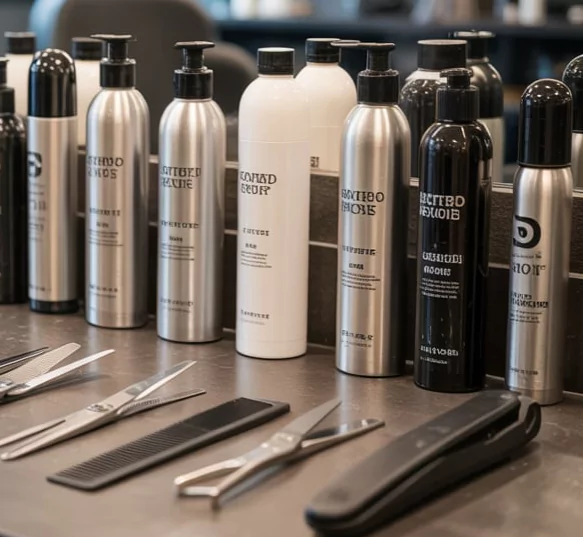
Over-direction in Haircut Techniques and Tools determines where hair naturally falls after cutting and creates specific shapes that couldn’t be achieved otherwise. This technique gives you precise control over graduation and balance.
Forward over-direction pulls hair toward the face before cutting. This creates longer lengths in the back and shorter lengths in the front—perfect for face framing layers that enhance facial features while maintaining overall length.
When cutting with forward over-direction, pull each section to a point in front of where it naturally falls. The amount of over-direction determines the intensity of the graduation. Slight forward over-direction creates subtle shape changes, while dramatic over-direction produces significant length variation.
Backward over-direction pulls hair away from the face, creating shorter lengths in the back and longer lengths in the front. This technique maintains length while removing weight from dense areas, particularly useful for thick or coarse hair that needs bulk reduction without length loss.
Perimeter preservation in Haircut Techniques and Tools often relies on backward over-direction. By pulling interior sections away from the perimeter before cutting, you can remove significant weight while maintaining the outer shape completely intact.
Side over-direction controls graduation in profile views and creates asymmetrical effects. Pull sections toward either side before cutting to create deliberate imbalance or correct natural growth pattern irregularities.
Finger angle control works in combination with over-direction to create precise shapes. Angling your fingers while over-directing hair creates compound graduation that appears completely natural when the hair falls into place.
The stationary guideline in layering relies on consistent over-direction to create even results. Choose a reference point, establish your guide section, then over-direct all subsequent sections to that same point while maintaining identical elevation.
Sectioning Hair: Mathematical Precision for Consistent Results
Professional sectioning hair follows mathematical principles that ensure predictable, consistent results. Random sectioning leads to uneven cuts and frustrated clients who can’t understand why their hair doesn’t look right.
Horizontal sections run parallel to the floor and create weight accumulation. Each horizontal section you cut adds to the weight line, building density in specific areas. Use horizontal sections for one length bob tutorial cuts and maintaining maximum weight distribution.
Section thickness directly affects cutting precision. Sections thicker than 1/4 inch become difficult to cut evenly, while sections thinner than 1/8 inch slow down the cutting process unnecessarily. The ideal section thickness equals about the width of your cutting comb.
Vertical sections run perpendicular to the floor and create layering effects. These sections remove weight and add movement, working perfectly for crown layering techniques and adding height to flat areas.
When cutting vertical sections, maintain consistent elevation throughout each section. Inconsistent elevation within a single section creates irregular results that appear choppy or uneven.
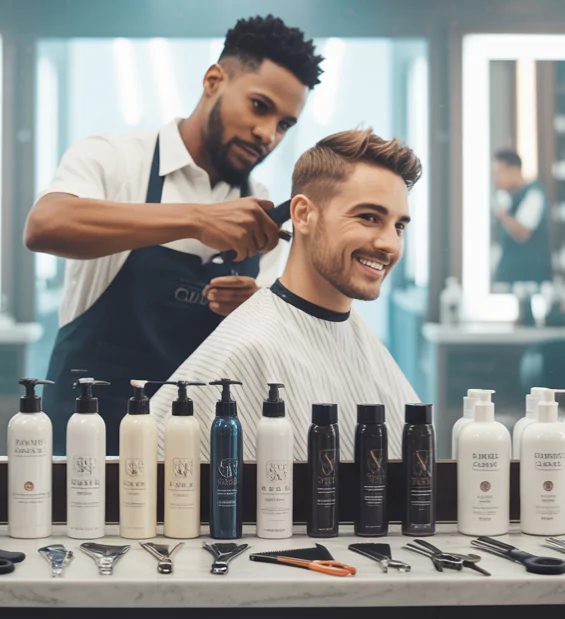
Diamond sectioning in haircutting isolates the crown area for precise volume control. Create a diamond shape by connecting four points: two at the high recession areas, one at the center of the forehead, and one at the crown. This natural sectioning pattern enables targeted crown volume creation without affecting surrounding areas.
The diamond section works because it follows the natural growth patterns of crown hair. Hair within this section grows in swirl patterns that benefit from isolated treatment.
Triangular sectioning removes weight from specific areas while maintaining surrounding length. Create triangular sections by connecting three points and cutting only the hair within that triangle. This technique works excellently for adding crown volume in long hair without creating visible layers throughout the rest of the cut.
Pie-shaped sectioning creates radial patterns that follow natural hair growth and head shape. Imagine the head as a pie and cut sections that radiate from a central point. This works exceptionally well for short to long Haircut Techniques and Tools and maintaining natural flow in curved perimeters.
Zigzag sectioning technique creates irregular cutting patterns that prevent harsh lines and add natural-looking texture. Instead of cutting straight across sections, create zigzag patterns that vary the cutting line. This technique produces invisible layers that add movement without obvious layering lines.
Tension in Haircutting: The Silent Skill That Changes Everything
Proper tension in haircutting ensures even length distribution and clean cutting lines. Inconsistent tension creates uneven results that are nearly impossible to correct and often require complete recutting.
Even tension requires steady, consistent pressure throughout each section. Hold hair firmly enough to maintain control but not so tightly that you stretch the hair unnaturally. You should be able to slide your fingers along the section without restriction or looseness.
Different hair types require specific tension adjustments. Fine hair stretches easily and needs lighter tension to prevent pulling it longer than its natural state. When fine hair snaps back after being stretched, it appears shorter than intended.
Thick, coarse hair requires firmer tension for control and precision. Without adequate tension, coarse hair won’t cut cleanly and may push away from the shears rather than cutting through properly.
Curly hair demands special tension considerations. Never stretch curly hair to its full length when cutting—this creates lengths that appear correct when stretched but too short when the curl returns. Cut curly hair with minimal tension to respect its natural spring.
Hair shaft alignment affects how tension translates to final results. All hairs within each section should lie parallel to each other when held under tension. Twisted or crossed hairs within sections create irregular lengths.
The stationary guideline in layering relies absolutely on consistent tension. Create your first guide section with perfect tension, then match that exact tension as you work through remaining sections. Any variation in tension will create uneven layering.
Professional stylists develop tension muscle memory through practice. Your fingers should automatically apply appropriate tension for different hair types without conscious thought. This automatic response allows you to focus on cutting precision rather than tension control.
Advanced Layering Techniques for Modern Styles
Understanding Layer Physics and Strategic Weight Removal
Hair layering techniques work by selectively removing weight from specific areas while maintaining length in others. Understanding the physics behind layering enables precise control over volume, movement, and final shape.
Weight in haircuts behaves like a seesaw—remove weight from one area and other areas appear heavier by comparison. Strategic weight removal creates the illusion of volume where weight remains while providing movement where weight is reduced.
Internal graduation removes weight without affecting the perimeter, creating movement within solid shapes. Cut interior sections shorter than exterior sections to create hidden layers that activate when styled but remain invisible when hair hangs naturally.
This technique works perfectly for clients who want movement and body but need to maintain a conservative appearance for professional settings. The movement appears when hair is styled but disappears when hair hangs naturally.
Invisible layers provide maximum movement with minimal visual layering. Use zigzag sectioning technique to create irregular cutting patterns that prevent harsh demarcation lines between different lengths.
The key to invisible layers lies in the irregular sectioning pattern. Instead of cutting straight horizontal lines that create obvious steps, zigzag sections create gradual transitions that blend seamlessly.
Disconnected layers create deliberate separation between lengths for maximum texture and movement. This technique works brilliantly for modern bob Haircut Techniques and Tools trends and adding dramatic movement to solid shapes.
Cut upper layers significantly shorter than lower layers, creating intentional gaps between lengths. When styled, these gaps create separation and texture that adds contemporary edge to classic cuts.
Classic Layering Methods with Modern Applications
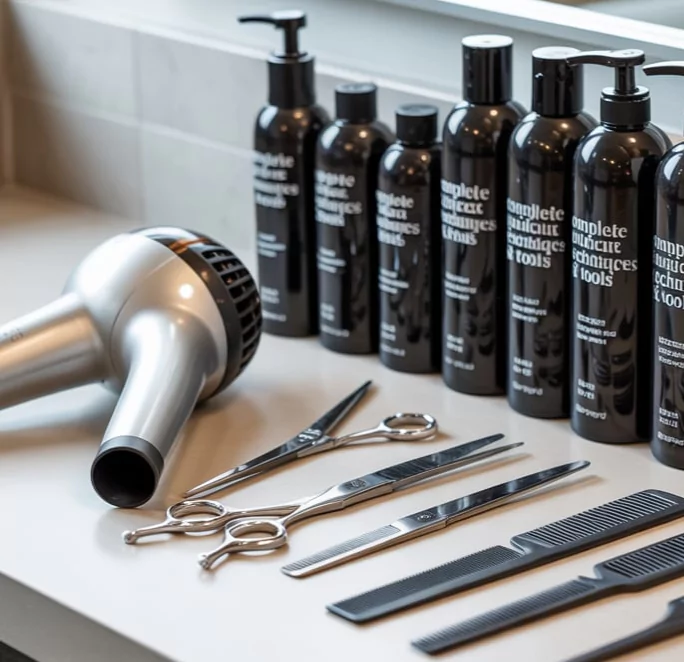
Long hair layering starts with establishing a guide in the crown area that determines the shortest length throughout the cut. Use 90-degree elevation and cut this section to your desired shortest point. This becomes your stationary guideline in layering for all subsequent sections.
Work in horizontal sections from crown to nape, maintaining consistent elevation and over-direction. Each section should be over-directed to your crown guide, creating seamless graduation throughout the entire cut.
The mathematical principle behind this technique ensures even layering: each section is cut to the same guide length, but because sections are different distances from the guide, they create natural graduation when they fall.
Ombre layering technique creates longer layers in the crown that gradually become shorter toward the perimeter. This technique mimics the natural way hair grows—longer at the crown, shorter at the hairline—creating extremely natural-looking results.
Start with minimal elevation in the crown area and gradually increase elevation as you work toward the perimeter. This creates subtle graduation that intensifies toward the ends.
Long layers with diagonal forward sections create face-framing effects while maintaining overall length. Cut diagonal sections that angle toward the face, creating longer lengths in the back and shorter lengths around the face.
This technique works because the diagonal cutting line naturally creates graduation when the hair falls into its natural position. The angles follow facial contours, enhancing features automatically.
Advanced Layering Innovations for Contemporary Looks
Twist cutting technique adds organic texture to layered cuts without creating harsh lines. Twist each section 180 degrees before cutting to create irregular lengths that blend naturally when the twist is released.
The twist creates a spiral cutting line that produces different lengths throughout the section. When released, these varied lengths create natural-looking texture that moves beautifully when styled.
Diamond sectioning in haircutting isolates specific areas for targeted layering without affecting surrounding hair. This technique enables precise crown volume creation without disturbing perimeter weight or face-framing areas.
Cut only the hair within the diamond section, leaving surrounding hair at its original length. This creates volume and lift exactly where needed without compromising the overall style.
Perimeter preservation in haircuts maintains length while adding internal movement through strategic layering. Cut all interior layers shorter than the perimeter to create volume and texture without sacrificing any length.
This technique satisfies clients who want movement and body but refuse to lose any length. The interior layers provide all the benefits of layering while the perimeter maintains maximum length.
Zigzag underlayering method creates hidden texture that activates when styled but remains invisible when hair hangs naturally. Part hair in zigzag patterns before cutting to ensure random length distribution.
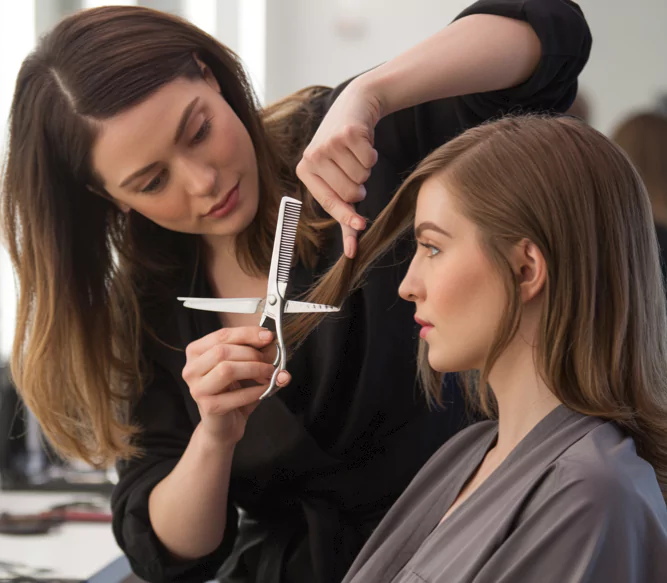
The irregular partings prevent the formation of obvious layering lines, creating texture that appears completely natural. This technique works exceptionally well for fine hair that shows every cutting line.
Fan technique for point cutting creates soft, feathered edges on layered cuts. Hold each section in a fan shape while point cutting to ensure even texture distribution across the entire width of the section.
Point cut into each part of the fanned section, creating consistent texture that doesn’t favor one side over the other. This prevents the lopsided texture that often results from improper point cutting.
Layer Balancing for Optimal Results
Layer balancing for thick hair requires understanding weight distribution and how different areas affect overall proportions. Thick hair tends to create pyramid shapes unless properly balanced through strategic layer placement.
Remove more weight from the crown and mid-length areas while maintaining weight at the perimeter. This creates the illusion of even density throughout while preventing the heavy bottom that characterizes unbalanced thick hair cuts.
Choppy layers prevention involves understanding section size, elevation consistency, and cutting angle precision. Choppy layers almost always result from inconsistent technique rather than hair characteristics.
Maintain identical section sizes, elevation angles, and tension throughout the cutting process. Any variation in these technical elements creates the uneven results that appear choppy.
Use soft blending with shears to correct any harsh transitions discovered during cross checking haircut techniques and tools. Point cutting or slide cutting can soften overly harsh lines while maintaining the basic layer structure.
Precision Cutting Fundamentals for Flawless Execution
One-Length Cuts: Achieving Mathematical Precision
One length bob tutorial techniques require absolute precision and unwavering consistency. These cuts show every imperfection, making technical excellence non-negotiable.
Start with thoroughly detangled, damp hair sectioned into horizontal layers no thicker than 1/4 inch. Thicker sections prevent even cutting, while thinner sections slow progress unnecessarily.
Establish your perimeter guide by cutting the bottom section at your desired length. Use zero elevation, even tension, and a steady cutting motion. This guide determines the accuracy of the entire haircut techniques and tools.
Work upward in horizontal sections, cutting each layer to match your guide exactly. Comb each section straight down, maintain zero elevation, and cut precisely to the established length.
Bob haircut perimeter techniques focus on creating clean, geometric lines that appear perfectly straight from every angle. Use confident, steady hand movements and avoid “sawing” motions that create jagged edges.
Each cut should be deliberate and complete. Hesitation or multiple small cuts create irregular edges that destroy the geometric precision essential to bob cuts.
French bob haircut techniques create shorter, more dramatic geometric shapes with extreme precision requirements. The shorter length makes every imperfection visible, demanding flawless execution.
Cut the perimeter first, establishing a strong foundation between the earlobe and jawline. Use one length bob haircut principles but work with extreme precision due to the unforgiving nature of the shorter length.
Hair perimeter detailing becomes crucial with shorter cuts. Clean up any irregularities with minimal point cutting technique applied sparingly. Too much point cutting destroys the geometric integrity that defines French bob styles.
Advanced One-Length Variations
Internal graduation on a blunt bob creates hidden movement within geometric shapes. Cut interior sections slightly shorter than the perimeter to add body and movement while maintaining the strong perimeter line.
This technique satisfies clients who love the look of geometric bobs but need additional body and movement for styling versatility. The movement remains hidden until activated through styling.
One length bob with texture combines geometric precision with contemporary softness. Cut the basic bob shape first, then add subtle texture through minimal point cutting or slide cutting.
Apply texture sparingly and strategically—too much destroys the geometric foundation, while too little fails to provide the desired softness.
Hair density adjustment within one-length cuts involves strategic thinning to prevent excessive weight accumulation. Use blending shears to remove bulk from dense areas while maintaining the overall shape.
Focus density reduction on areas that naturally accumulate weight, typically the nape and lower crown areas. Remove weight gradually, checking frequently to prevent over-thinning.
Cross-Checking Systems for Quality Assurance
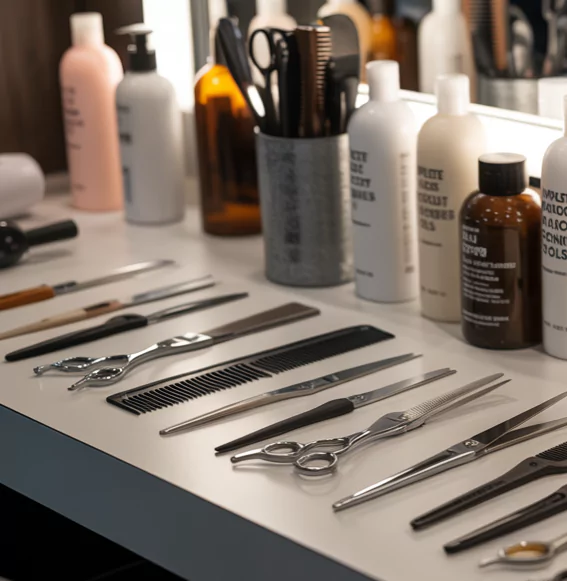
Cross checking haircut techniques and tools reveals inconsistencies invisible during the cutting process. This systematic approach separates professional results from amateur attempts.
Horizontal cross-checking involves combing hair perpendicular to your original cutting sections. Any uneven areas become immediately apparent as irregular lengths that disrupt the smooth line.
Check the entire perimeter by combing hair straight down and examining the cutting line from multiple angles. Look for any areas that appear longer or shorter than surrounding sections.
Vertical cross-checking reveals balance issues between left and right sides. Comb hair straight down and compare lengths at identical points on both sides of the head.
Use landmarks like the ears, jawline, and shoulder line to ensure perfect symmetry. Even slight differences between sides become obvious when hair is combed straight down.
Diagonal cross-checking reveals graduation consistency in layered cuts. Comb hair at diagonal angles to reveal whether your elevation and over-direction produced smooth transitions between lengths.
Look for any areas where the graduation appears stepped or uneven. These indicate inconsistent elevation or over-direction during the cutting process.
Face-Framing and Bang Techniques for Feature Enhancement
Face Shape Analysis and Strategic Enhancement
Hairstyles for face shape require understanding facial geometry and how hair placement affects visual proportions. Strategic face framing layers can enhance positive features while minimizing less favorable ones.
Oval faces represent the ideal proportion and work well with most styles. However, they look exceptional with long curtain fringe that enhances natural balance without disturbing ideal proportions.
Avoid styles that add unnecessary width or height to oval faces. Instead, focus on maintaining the natural balance while adding movement and texture for contemporary appeal.
Round faces benefit from vertical lines and angles that create length illusion. V-shaped layers that point downward elongate the appearance while face framing layers that start below the chin add vertical emphasis.
Cut face-framing layers longer than the widest part of the face to avoid emphasizing roundness. Layers that end at the cheek level make round faces appear wider.
Square faces soften with curved lines and wispy ends around the jawline. Face-framing technique should focus on creating softness rather than sharp angles that emphasize the square jaw.
Use twist cutting around the face to create soft, irregular lengths that move naturally. Avoid blunt lines that mirror the square jaw line.
Heart-shaped faces need width at jaw level to balance the wider forehead. Face framing layers for fine hair should add fullness around the chin area while keeping volume controlled at the temples.
Cut layers that flare outward at jaw level to create the illusion of width where it’s needed most. Avoid volume at the temples that would emphasize the already-wide forehead.
Long faces benefit from width-creating techniques and horizontal lines. Cut layers that add width at the cheek and jaw levels while avoiding excessive height at the crown.
Professional Bang Cutting Methods
Cutting bangs requires understanding growth patterns, facial features, lifestyle factors, and maintenance commitment. Never cut bangs without thorough consultation about styling expectations and maintenance willingness.
Full fringe cutting starts with identifying natural hairline patterns and cowlick directions. Section a triangular area from the high points of the eyebrow arches—this creates appropriate width for most face shapes.
The triangle should extend back to the crown area, including enough hair to create fullness without appearing thin or sparse. Too narrow a section creates stringy bangs that separate into pieces.
Cut the center section first, establishing your length guide at the desired point. Most full fringes work best when cut between the eyebrows and eyelashes, but individual features may require adjustments.
Work outward from the center in small sections, following the natural curve of the eyebrows. This creates a soft arch that follows facial contours rather than a harsh straight line.
Use point cutting technique sparingly to soften harsh lines and create natural movement. Over-point cutting creates gaps that make full fringes appear thin and patchy.
Side sweeping fringe requires asymmetrical length distribution that creates natural flow to one side. Start longer on the side where hair will sweep and gradually decrease length toward the shorter side.
Use over-direction in haircutting to create the natural flow pattern. Pull all sections toward the direction of the intended sweep before cutting to ensure the hair falls naturally into position.
Curtain fringe techniques split hair down the center and create longer sections that frame both sides of the face. Cut each side independently, maintaining symmetrical lengths while using twist cutting for soft texture.
Start with hair parted down the center and cut each side separately. The longest point should hit at the cheekbone level for most face shapes, creating flattering frames on both sides.
Advanced Face-Framing Innovations
Front twist cutting technique creates soft, organic face-framing layers without harsh geometric lines. Twist small sections before cutting to create irregular lengths that blend naturally with surrounding hair.
The twist creates a spiral cutting line that produces varied lengths throughout each section. When released, these irregular lengths create natural-looking texture that moves beautifully around the face.
Razor cutting face frames produces ultra-soft texture perfect for fine hair that doesn’t hold traditional cutting lines well. Use a Sam Villa Signature Series Razor with light pressure to create feathered edges.
Razor techniques require damp hair and confident strokes. Work from longer to shorter lengths, using the razor to create soft graduation that appears completely natural.
Finger placement in haircutting controls the final result when creating face frames. Angle fingers to match desired graduation and maintain consistent angles throughout the cutting process.
Use your fingers as a guide for graduation intensity. Steeper finger angles create more dramatic graduation, while subtle angles produce soft, natural-looking frames.
Creating visual interest in haircut techniques and tools around the face involves varying lengths and textures to prevent monotonous framing. Combine different cutting techniques within the face frame for contemporary appeal.
Use slide cutting on some sections and point cutting on others to create varied textures that add interest without appearing chaotic or unplanned.
Specialized Cutting Techniques for Diverse Hair Types
Cutting Strategies for Specific Hair Textures
How to cut layers in straight hair requires different approaches than curly or wavy textures. Stick-straight hair layers reveal every imperfection, demanding absolute precision in execution.
Straight hair shows cutting lines clearly, making consistent technique essential. Any variation in elevation, tension, or cutting angle becomes visible in the final result.
Use fanning sections to ensure even weight distribution throughout straight hair layers. Fan each section slightly before cutting to prevent gaps and maintain consistent density.
Point cutting for layers works exceptionally well in straight hair because the irregular lengths prevent harsh demarcation lines. Point cut sparingly—too much creates gaps, while too little leaves harsh lines.
Hair shaft alignment becomes crucial with straight hair because misaligned hairs within sections create obvious irregularities. Ensure all hairs lie parallel when held under tension.
Layering long thick hair requires strategic weight removal without creating bulk accumulation at specific points. Use disconnected layers to remove weight while maintaining overall length and preventing pyramid shapes.
Remove more weight from crown and mid-length areas while preserving perimeter weight. This creates better proportion and prevents the bottom-heavy appearance common in thick, layered hair.
Adding dimension to long hair involves creating subtle length variations that catch light differently. Use slide cutting to create soft graduation that adds movement without obvious layering lines.
Fine hair cutting strategies focus on creating the illusion of density while adding maximum movement. Fine hair benefits from blunt cutting lines that create the appearance of thickness.
Avoid over-layering fine hair, which removes the limited density available. Instead, use strategic layering that adds movement while preserving as much density as possible.
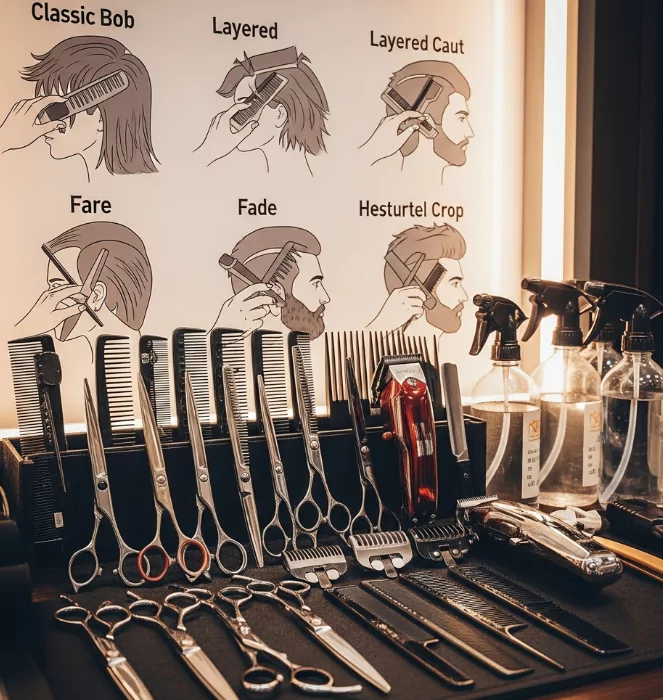
Texturizing short hair requires understanding how different techniques affect styling and maintenance. Short hair shows texture more dramatically than long hair, making technique selection crucial.
Use point cutting technique for subtle texture that adds movement without creating maintenance challenges. More aggressive texturizing techniques often create styling difficulties in short hair.
Modern Shag Techniques for Contemporary Appeal
Shag haircut styles combine multiple layering techniques to create textured, lived-in appearances that work with natural hair movement rather than against it.
Modern shags differ from classic 1970s versions by incorporating more precise cutting methods and strategic placement. Contemporary shags appear effortless but require skilled execution.
Start with long layers with diagonal forward sections to establish the basic framework. This creates the foundation for adding texture and movement throughout the cut.
The diagonal sections create natural face-framing while the layering provides body and movement. This combination forms the basis for all shag variations.
Use texturizing short hair techniques in the crown area to create volume and separation without excessive bulk. Slide cutting works perfectly for adding texture while maintaining length.
Crown layering techniques become crucial in shag cuts because crown volume defines the style’s characteristic. Use diamond sectioning in haircutting to isolate the crown for targeted treatment.
Ombre layering technique creates the graduated length variation that characterizes shag cuts. Start with longer layers at the crown and gradually decrease length toward the perimeter.
This creates the tousled, natural appearance that makes shags appear effortless when styled. The key lies in making the graduation appear random rather than systematic.
Choppy layers prevention matters even in textured cuts because intentional texture differs significantly from accidental choppiness. Use fan technique for point cutting to ensure texture appears deliberate.
Pixie Cut Mastery for Short Hair Specialists
Undercut pixie haircut techniques and tools require understanding graduation principles and blending methods. The contrast between short sides and longer top sections demands precise transition zones.
Create the undercut first, establishing clean lines that will support the longer top sections. Use male clippers for consistency, then blend the transition zone with shears.
Blending shear techniques create smooth transitions between dramatically different lengths. Use texturizing shears with appropriate tooth counts for the desired transition intensity.
Fewer teeth create subtle blending, while more teeth provide aggressive texturizing. Choose based on the hair type and desired contrast level.
Pixie haircut blending tips focus on creating seamless connections between sections without obvious demarcation lines. Use over-direction in haircutting to pull longer sections over shorter areas.
This creates natural flow that appears effortless while maintaining the structured foundation essential to pixie cuts.
Ergonomic hand position in haircutting becomes especially important with pixie cuts due to the precision required and awkward angles involved. Maintain comfortable wrist positions and take breaks to prevent fatigue.
Fatigue leads to mistakes that are particularly visible in short, precise cuts. Plan your cutting sequence to minimize awkward positions and hand strain.
Cutting-in-Motion and Advanced Professional Methods
Shear Entry Angles and Professional Flow
Cutting-in-motion techniques separate advanced stylists from beginners by creating fluid, confident cutting that produces superior results in less time.
Understanding shear entry angle enables smooth cutting motions that slice through hair cleanly rather than pushing or tearing. Proper angle creates effortless cutting that reduces hand fatigue.
Enter hair sections with shears at approximately 45 degrees to the hair shaft. This angle allows clean slicing while maintaining control and precision.
Motion cutting techniques require sharp, well-maintained shears and confident hand movements. Hesitation or multiple small cuts destroy the smooth flow essential for this approach.
Develop rhythm in your cutting that matches your natural hand movement patterns. Fighting your natural rhythm creates tension and reduces cutting quality.
Shear-to-hand relationship affects both cutting efficiency and result quality. Position shears to work with your hand’s natural movement rather than forcing awkward positions.
Hold shears with relaxed fingers that can adjust position smoothly. Tense grips create fatigue and reduce cutting precision.
Professional Finishing Techniques for Exceptional Results
Hair movement and softness result from proper finishing techniques applied after the basic cut structure is complete. These details transform good cuts into exceptional ones.
Slide cutting for softness removes weight without affecting overall length. Open shears slightly and slide down hair sections while applying gentle closing pressure.
This technique creates natural-looking texture that moves beautifully when styled. The key lies in consistent pressure and smooth movement throughout each section.
Removing weight & adding volume simultaneously requires strategic technique application. Use blending shear backstroke technique to remove weight from dense areas while creating lift in fine areas.
Work against the natural hair growth direction to create lift and volume while removing excess weight. This dual action creates better proportions and styling versatility.
Point cut vs blunt cut decisions affect the final texture and movement
Troubleshooting Common Problems and Advanced Solutions
Diagnosing and Correcting Cutting Mistakes
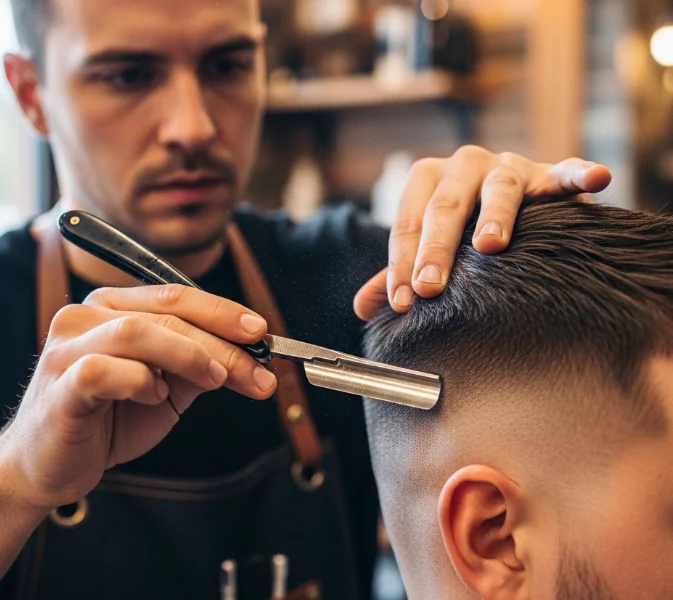
Fixing choppy layers requires understanding why they occurred and addressing the root cause rather than just the symptoms. Choppy layers typically result from inconsistent elevation, uneven tension, or irregular section sizes.
Analyze the cutting pattern to identify where consistency broke down. Look for areas where elevation changed unexpectedly or where section sizes varied significantly.
How to prevent choppy layers involves maintaining steady technique throughout the cutting process. Use identical section sizes, consistent elevation angles, and even tension from start to finish.
Develop cutting rhythm that naturally maintains consistency. Rushing or hesitating disrupts the flow that creates smooth results.
Use soft blending with shears to correct harsh transitions discovered during quality control checks. Point cutting technique applied strategically can soften overly harsh lines while maintaining the basic layer structure.
Perimeter safe layering prevents damage to the overall shape while correcting interior problems. Always preserve the perimeter length while making corrections to internal layers.
Work conservatively when making corrections—it’s easier to remove more hair than to replace what’s been cut. Make small adjustments and check frequently.
Prevention Strategies for Professional Excellence
Haircutting comfort techniques prevent the fatigue that leads to technical mistakes. Maintain proper posture and use ergonomic haircutting posture principles throughout extended cutting sessions.
Position your cutting station to minimize reaching and stretching. Keep tools within easy reach and adjust chair heights for optimal working positions.
Shear and hand position in haircutting affects both comfort and cutting accuracy. Keep wrists straight and elbows close to your body for maximum control and minimum strain.
Tension in your hands and arms translates to cutting inconsistencies. Practice relaxed grips that maintain control without creating unnecessary tension.
Take regular breaks during long cutting sessions to prevent fatigue-induced mistakes. Even brief pauses help maintain focus and technical precision.
Professional haircutting videos and continuing education resources keep skills sharp and introduce new techniques. Industry trends evolve rapidly, making ongoing education essential for career advancement.
Subscribe to professional publications and attend workshops regularly. The investment in education pays dividends through improved skills and increased client satisfaction.
Advanced Problem-Solving Techniques
Density contrast correction involves balancing areas of varying hair thickness within single haircuts. Some clients have naturally uneven density that requires strategic cutting adjustments.
Remove additional weight from dense areas while preserving limited density in thinner areas. Use texturizing shears selectively to create more even apparent density.
Crown volume creation in flat or fine hair requires understanding the natural growth patterns and working with them rather than against them. Diamond sectioning in haircutting isolates the crown for targeted treatment.
Cut crown sections slightly shorter than surrounding areas to create lift when styled. The shorter length provides support for longer sections, creating natural volume.
Hair shaft alignment problems create irregular cutting results even with perfect technique. Ensure all hairs within each section lie parallel before cutting to prevent uneven lengths.
Check section preparation carefully—twisted or crossed hairs within sections create the irregular results that appear to be cutting mistakes.
Specialized Advanced Techniques for Expert Stylists
Invisible Layering Methods
Invisible layers haircut techniques and tools create maximum movement with minimal visual layering lines. These sophisticated methods satisfy clients who want the benefits of layering without obvious stepped appearances.
Zigzag underlayering method creates hidden texture through irregular sectioning patterns. Instead of cutting straight horizontal lines, create zigzag patterns that vary the cutting line continuously.
This technique prevents the formation of obvious demarcation lines while providing all the movement benefits of traditional layering. The irregular pattern creates seamless transitions.
Internal graduation removes weight from interior sections while maintaining perimeter integrity. Cut interior layers progressively shorter while leaving the exterior shell at full length.
This creates movement and body that activates when styled but remains hidden when hair hangs naturally. Perfect for conservative environments that require neat appearances.
Triangular sectioning enables targeted weight removal from specific areas without affecting surrounding hair. Create triangular sections around areas that need weight reduction, cutting only the hair within those triangles.
This surgical approach to layering creates precise results without unwanted side effects in other areas of the cut.
Contemporary Bob Variations
Graduated bob haircut techniques and tools tutorial techniques create sophisticated shapes that work beautifully with modern styling methods. These cuts combine classic principles with contemporary execution.
Start with a solid perimeter foundation, then add subtle graduation that creates movement without destroying the bob’s characteristic weight line.
Use 15-degree elevation for subtle graduation that adds body while maintaining the strong perimeter essential to bob cuts. Higher elevations destroy the bob’s fundamental character.
French bob cutting requires extreme precision due to the shorter length and geometric demands. Every cutting line must be perfect because mistakes are impossible to hide.
Cut the perimeter first, establishing mathematical precision in the foundational line. Work in extremely thin sections to ensure absolute accuracy.
Internal graduation on a blunt bob adds hidden movement within geometric shapes. Cut interior sections slightly shorter than the perimeter to create body that activates when styled.
This technique satisfies clients who love bob geometry but need additional movement for styling versatility. The graduation remains invisible until activated through styling.
Modern bob haircut techniques and tools trends incorporate contemporary texturing techniques with classic bob structures. Add subtle texture through strategic point cutting technique or minimal slide cutting.
Apply texture conservatively—too much destroys the geometric foundation that defines bob cuts. Focus on creating softness without compromising structural integrity.
Advanced Face-Framing Systems
Face framing layers for fine hair require understanding how different techniques affect limited density. Fine hair shows every cutting line clearly, making precision essential.
Use twist cutting layers tutorial to create soft face-framing that doesn’t appear harsh or obvious. The irregular lengths created by twist cutting blend naturally with fine hair’s characteristics.
Creating fullness with face framing layers involves strategic placement that adds apparent density around the face. Cut layers that flare outward rather than lying flat against the face.
Razor cutting face frames in fine hair creates ultra-soft texture that moves naturally. Use light pressure and confident strokes to create feathered edges that enhance fine hair’s natural movement.
Long layers with face framing combine overall length maintenance with strategic framing around facial features. Use diagonal forward sections to create natural graduation toward the face.
Face framing tutorial on a short bob requires precision because shorter lengths show every imperfection. Work conservatively, removing small amounts and checking frequently.
Use point cutting technique sparingly to create soft edges that don’t compromise the bob’s geometric integrity. Too much point cutting destroys the clean lines essential to bob cuts.
Cutting for Volume and Movement in Fine Hair
Volume and movement in fine hair requires techniques that maximize apparent density while adding styling versatility. Fine hair benefits from strategic cutting that creates the illusion of thickness.
Disconnected layers for movement create separation between lengths that adds body when styled. Cut upper layers significantly shorter than lower layers to create intentional gaps.
These gaps fill with air when styled, creating volume and movement that fine hair often lacks naturally. The disconnection prevents layers from lying flat against each other.
Adding crown volume in long hair through strategic layering provides lift without sacrificing overall length. Use diamond sectioning to isolate crown areas for targeted treatment.
Cut crown sections progressively shorter to create natural lift that supports longer sections. This creates the foundation for voluminous styling without requiring excessive products.
Ombre layers for long hair create graduated length variation that adds movement throughout the cut. Start with minimal layering at the crown and increase layering intensity toward the ends.
This technique mimics natural hair growth patterns, creating extremely natural-looking results that move beautifully when styled.
Building Your Professional Cutting Skills
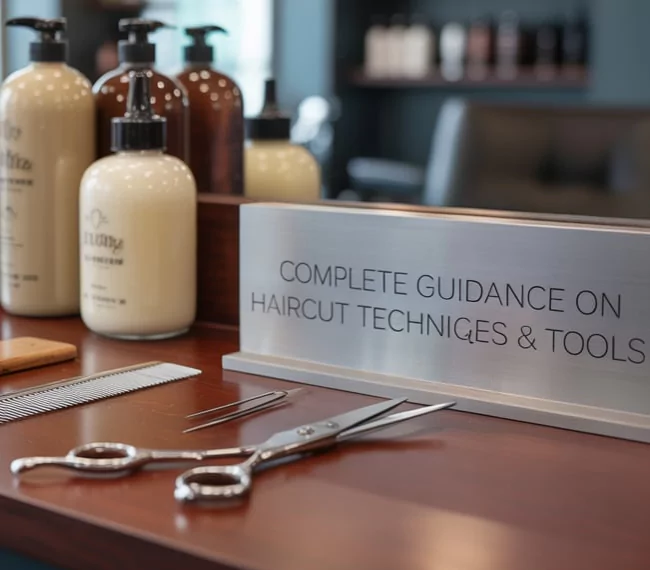
Systematic Skill Development
Hair stylist training programs provide structured learning paths that build skills systematically. However, real expertise comes from deliberate practice and continuous refinement of fundamental techniques.
Focus on mastering basic haircut techniques and tools foundations before attempting advanced techniques. Solid fundamentals enable you to execute any style request with confidence.
Free haircutting training resources provide valuable foundation knowledge, but hands-on practice develops the muscle memory essential for professional results. Use practice mannequins to develop technique without pressure.
Professional haircut techniques & tools videos offer visual learning that complements written instruction. Sam Villa haircut tutorials demonstrate industry-standard techniques used in top salons worldwide.
Study these videos frame by frame to understand hand positions, cutting angles, and sectioning patterns. Visual learning accelerates skill development significantly.
Hair stylist video guide resources show techniques in motion, revealing details impossible to convey through static images or text descriptions.
Advanced Skill Building Strategies
Advanced hair cutting methods build upon fundamental techniques to create sophisticated results. Master basic methods completely before progressing to advanced applications.
Cutting techniques for salon professionals workshops provide hands-on experience with new methods and direct feedback from expert instructors. These workshops often introduce techniques before they become mainstream.
Industry certifications validate your skills and provide credibility with clients who research their stylists’ qualifications. Many continuing education programs offer certification upon completion.
Haircutting education online platforms provide flexible learning schedules that fit busy professional lives. However, supplement online learning with hands-on workshops for complete skill development.
Modern haircut techniques and tools trends 2024 continue evolving, but fundamental techniques remain constant. Master the foundations, and you’ll adapt easily to any style trend that emerges.
Professional Development and Career Advancement
Haircut tips for stylists from industry veterans emphasize the importance of consistent technique development and client relationship building. Technical skills alone don’t guarantee success.
Develop consultation skills that help clients articulate their desires and understand maintenance requirements. Many client dissatisfaction issues stem from miscommunication rather than technical problems.
Professional dry cutting shear techniques and advanced tool knowledge separate expert stylists from average practitioners. Invest in quality tools and learn to use them expertly.
Tool knowledge includes understanding when different tools are appropriate and how to maintain them for optimal performance. Dull or damaged tools create subpar results regardless of skill level.
Building a specialty focus within cutting—whether it’s short cuts, long hair, or specific textures—helps establish your reputation and attracts targeted clientele.
Specialization allows for deeper skill development and creates referral opportunities from clients who need services outside your specialty area.
Conclusion: Your Path to Cutting Mastery
Mastering hair cutting techniques represents a lifelong journey of continuous learning and skill refinement. The techniques outlined in this comprehensive guide provide the foundation for professional success, but expertise comes from consistent application and persistent improvement.
Start with fundamental haircut techniques and tools foundations and build skills systematically. Focus on precision before attempting speed—accuracy always trumps velocity in professional haircutting. Every cut should demonstrate your commitment to excellence.
Professional cutting shears and quality tools make precision possible, but they don’t create great cuts automatically. Your hands, guided by knowledge and experience, transform tools into instruments of artistic expression.
Best hair cutting techniques evolve with fashion trends and client preferences, but mathematical principles of elevation, over-direction, and sectioning remain constant. Master these fundamentals, and you’ll adapt successfully to any style evolution.
The most successful stylists understand that hairdressing tools and hair cutting techniques work together like instruments in an orchestra. Each element must perform perfectly to create the harmonious results clients expect and deserve.
Modern haircut techniques and tools trends 2024 will inevitably give way to new styles in coming years, but stylists who master fundamental techniques adapt effortlessly to change. Your technical foundation provides the confidence to tackle any cutting challenge.
Remember that every expert was once a beginner facing the same learning challenges you encounter. The difference between those who achieve mastery and those who remain average lies in commitment to improvement and willingness to learn from both successes and mistakes.
Hair stylist training never truly ends because the industry evolves continuously. Embrace this constant learning as an exciting aspect of your profession rather than a burden. Each new technique mastered expands your creative possibilities.
Your cutting skills will determine your professional trajectory and client satisfaction levels. Invest time in proper training, quality tools, and deliberate practice. This investment pays dividends throughout your career in client loyalty, professional recognition, and personal fulfillment.
The journey to cutting mastery challenges you to grow continuously while providing the satisfaction of creating beauty and confidence in every client. Embrace this journey with enthusiasm, knowing that each cut brings you closer to the expertise that defines truly exceptional stylists.
Additional Professional Resources
Professional haircutting videos from industry leaders provide ongoing education and inspiration. Subscribe to platforms that feature multiple instructors to expose yourself to different techniques and approaches.
Haircutting guide about haircut techniques and tools resources should include both foundational instruction and advanced techniques. Build a professional library that supports your continuous learning goals.
Best texturizing shears and tool recommendations change as technology advances. Stay informed about new tool developments that could improve your cutting efficiency and results.
Modern bob haircut techniques and tools trends and style evolution information helps you stay current with client requests. Understanding trend directions enables proactive skill development.
Your commitment to excellence in hair cutting techniques sets you apart in a competitive industry. Use this guide as your foundation, but never stop learning, practicing, and refining your craft. Your clients—and your career—depend on your dedication to continuous improvement.
FAQs on How to Cut Men’s Hair
1. What tools are best for cutting men’s hair at home?
For a clean man cut, you need professional clippers, sharp haircutting scissors, combs, and blending shears as the core Haircut Techniques & Tools.
2. Is it better to cut men’s hair wet or dry?
Cutting wet hair is ideal for scissor work, while dry hair makes clipper fades and hair designing cutting more precise.
3. How do you start a basic men’s haircut?
Begin with the sides using a higher clipper guard, then taper toward the neckline before shaping the top for a polished man cut.
4. What common mistakes should I avoid when cutting men’s hair?
Don’t rush, don’t cut too short too quickly, and always use the right Haircut Techniques & Tools to avoid uneven hair designing cutting.




